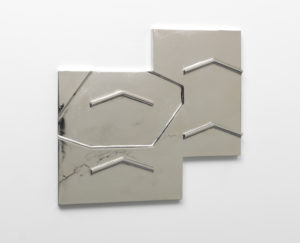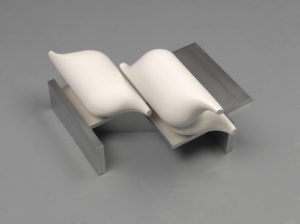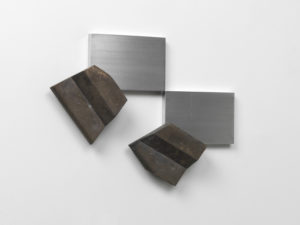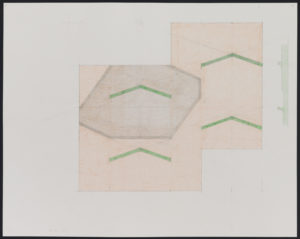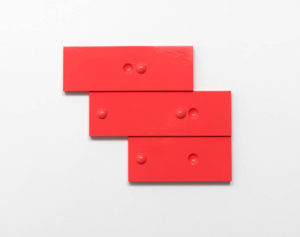January 3, 2013—February 16, 2013 | Reception: Thursday, January 3rd, 6 – 8pm
James Harris Gallery is pleased to present our fifth solo exhibition by Richard Rezac. The exhibition consists of five sculptural works and two drawings that identify the core practices and strategies Rezac developed to investigate geometric abstraction. The drawings are studies for the sculptures. Each sculptural piece is meticulously worked out on paper where each element has an analytical relationship to one another. The drawings are therefore and insight into the artist’s working process and yet are beautiful works on their own.
Rezac creates subtle compositions imbued with dynamic tension. He sensitively juxtaposes both materials, such as painted wood with aluminum or cast bronze, and color, making his practice a reductive one that brings together a minimal number of elements within any one work. Rezac’s sculptures are intimate and quietly inform the spaces they occupy. Each work is purposely situated, whether on floor, mounted on the wall or hanging above. His sculptures push the conventions of sculpture through its placement or location and the consequent relationship to the viewer.
Made out of cast plaster and aluminum, the floor sculpture “Untitled (11-02)” is intimate and elegant. Three swelling ovoid cast forms with tapered ends are situated on top of an aluminum support. The curving oblong shapes of plaster not only contradict the geometric rectangles of the metal but also call attention to the physical properties of each material. Repetition is an important element of Rezac’s vocabulary. There is interplay between biomorphic volume and hard edge geometric form. In another work, “Untitled (12-03)” three horizontal bands are positioned in an even step formation. A meticulous pattern of convex and concave circles punctuates each band giving it rhythm. Rezac’s choice of color, a glossy coral, imbues the piece with a quality of the manufactured but upon closer inspection; the hand of the artist is revealed. . While still sculptural, it is significant that “Untitled (12-03)” is attached especially close and parallel to the wall. Departing from the conventions of relief sculpture, which relies on projected form and shadow for effect, these works hover ambiguously between painting and sculpture.
Richard Rezac’s sculpture has been shown nationally and internationally, most notably in a 2006 survey of his work at the Portland Art Museum. Other venues include Yale University Art Gallery, the Art Institute of Chicago and Museum of Contemporary Art in Chicago, and the Corcoran Gallery of Art, Washington D.C. Rezac has received Fellowship Grants from the Guggenheim Foundation, the Joan Mitchell Foundation and the Tiffany Foundation and in 2006, the coveted Rome Prize from the American Academy in Rome. He lives and works in Chicago.
Richard Rezac
Richard Rezac (b. 1952, Nebraska) creates refined, and elegant objects comprised of pure reductive forms; his inspiration drawn in part from emotive encounters with architectural and design details situates his work closely to the Post-minimalist artists of the 1980s. Human in scale and mounted on the wall, suspended from the ceiling, or placed on the floor, Rezac’s sculptures open viewers to close-looking and reflection upon the forms. Surfaces of painted and natural wood, aluminum and bronze contain subtleties that reveal the pristine sculptures as actually handmade. Richard Rezac has received prestigious awards including the John Simon Guggenheim Memorial Foundation Fellowship, the Joan Mitchell Foundation Award, Louis Comfort Tiffany Foundation Award, and the Rome Prize Fellowship from the American Academy in Rome. He has exhibited at the Art Institute of Chicago, Museum of Contemporary Art- Chicago, Yale University Art Gallery, Aspen Art Museum, Portland Art Museum and others. Public collections include the Art Institute of Chicago, Dallas Museum of Art, Portland Art Museum, Detroit Institute of Art, and the Smart Museum at the University of Chicago, among others. Rezac lives and works in Chicago, IL where he is Adjunct Professor of Sculpture, Drawing, and Graduate Advising at The School of the Art Institute of Chicago (SAIC).
(copied from Rhona Hoffman)
nickel-plated bronze
16" x 17 1/2" x 1 1/4"
Private Collection
Inquire about this work
cast hydrocal and aluminum
10 1/2" x 19" x 18 3/4"
Inquire about this work
Cast bronze
13 1/2" x 17 3/4" x 2 1/2"
Private Collection
Inquire about this work
Colored pencil, pencil on paper
24 3/8" x 30 3/8"
Inquire about this work
Painted maple wood
16" x 19 3/4" x 1 1/2"
Inquire about this work
Painted cherry wood and aluminum
12 1/4" x 20 1/2" x 5 3/4"
Collection of De Paul University, Chicago, Illinois
Inquire about this work

